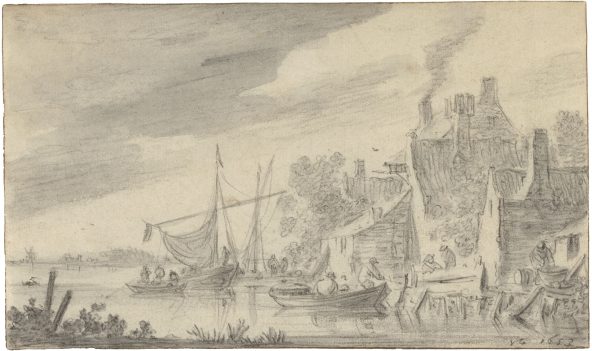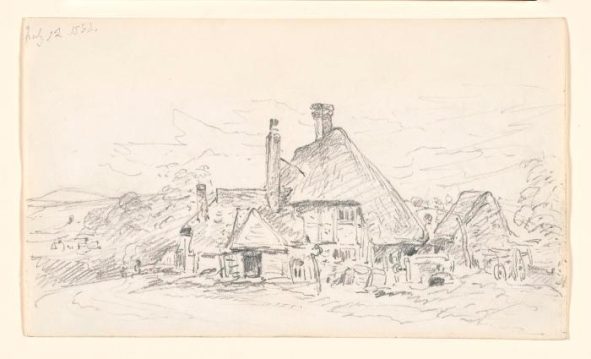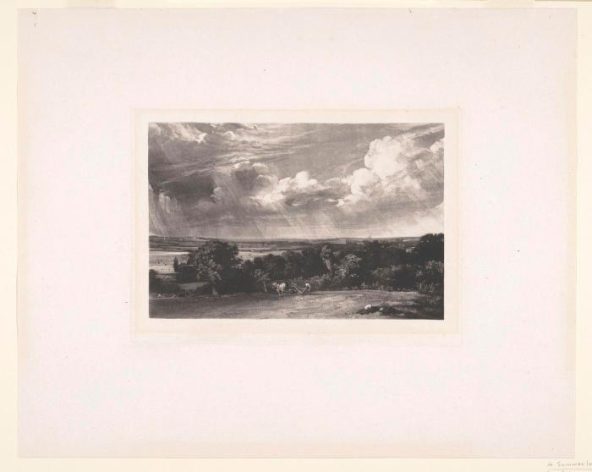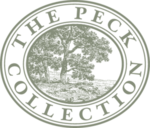Article: John Constable and the Dutch Landscape Tradition
Focus on the Peck Feature
Seventeenth-century Dutch landscapes, with their emphasis on vivid naturalism, have captivated the imaginations of British artists for centuries. This Focus on the Peck Collection installation highlights the work of two artists separated by some 200 years: Dutch artist Jan van Goyen (1596-1656) and English artist John Constable (1776-1837). When shown together, numerous parallels emerge between their work, including their working method, their choice of subject matter, and their use of light and dark to create dramatic atmospheric effects, revealing a dynamic conversation across the centuries.
Seventeenth-century Dutch landscapes, with their emphasis on vivid naturalism, have captivated the imaginations of British artists for centuries. Paintings, prints, and drawings of the Netherlandish countryside, in which scenes of riverbeds, farmhouses, and rural workers take pride of place, provided significant inspiration across the Channel even into the nineteenth century.
This Focus on the Peck Collection installation highlights the work of two artists separated by some 200 years: Dutch artist Jan van Goyen and English artist John Constable. Both considered among the most influential landscape painters of their times, each roamed their respective countrysides in search of local scenery, documenting the ever-shifting atmosphere and the people within it. One drawing by Van Goyen from the Peck Collection is juxtaposed here with two works by Constable — a sketch and a print made after one of Constables compositions. When shown together numerous parallels emerge, revealing a dynamic conversation across the centuries. For instance, notice their working method, their choice of subject matter, and their use of light and dark to create dramatic atmospheric effects.
This installation marks the first in our ongoing series showcasing drawings from the Peck Collection to occur after the tragic loss in April of patron and friend to the Ackland, Dr. Sheldon Peck, who together with his wife Leena, donated their magnificent collection of Dutch and Flemish drawings to the Museum in 2017. We hope that this display, as well as countless others in the future, will honor his legacy and continue to inspire our visitors.
Jan van Goyen

Jan van Goyen, Dutch, 1596 – 1656, River Scene with Boats near a Jetty by a Tavern, 1653, black chalk and gray wash, The Peck Collection, 2017.1.39
See River Scene with Boats near a Jetty by a Tavern in more detail here.
Jan van Goyen specialized in landscape views and produced more than 1,000 drawings over the course of his career, reflecting the immense pride shared among Dutch citizens for their land and culture. Many finished works, like this one, were based on sketches from life and were offered for sale on the open market. In this river scene, a shroud of heavy clouds extends across the sky as boats sail to and from the jetty located beside the tavern. Chimney smoke suggests increasingly windy conditions, but the water remains calm for now as figures go about their daily business. Using charcoal to cursorily lay out the scene, Van Goyen added liberal amounts of wash in varying tones of gray to produce dramatic contrasts of light and dark, conveying form, space, texture, and in this instance, a somewhat ominous atmosphere.
John Constable

John Constable, British, 1776 – 1837, A Thatched Farmhouse, 1834, pencil, Gift of Julie and Lawrence B. Salander, in honor of Richard B. Gersten, Class of 1970, 2003.34.4
See A Thatched Farmhouse in more detail here.
John Constable admired seventeenth-century Dutch art. As a young artist he sketched copies of Dutch landscape paintings that were on display in London, taking special note of the low horizon lines and extensive skies. As a collector he owned numerous Netherlandish landscape prints, and in his writings, he celebrated the ability of Dutch landscapists to elevate ordinary scenes with a sense of grandeur. Like Jan van Goyen’s drawing to the left, Constable chose a humble view as his subject, in this instance a rural farmhouse located above a modest valley rendered with freshness and vitality. Like his Dutch predecessors, Constable sketched his views from nature, often using the drawings as the basis for finished works.

David Lucas, British, 1802 – 1881, after John Constable, British, 1776 – 1837, A Summerland, from Various Subjects of Landscape, Characteristic of English Scenery, 1829-1830, mezzotint, Gift of the Ackland Associates, 85.13.4.1.
Much like Jan van Goyen before him, John Constable shared a sense of national pride for the British countryside and was particularly interested in the powerful effects of light and atmosphere found in the rural landscape. This work, engraved by artist David Lucas, belongs to a series of twenty-two prints after Constable’s drawings and oil sketches. Called Various Subjects of Landscape, Characteristic of English Scenery the group was partly a manifesto of the artist’s ideas about landscape. In the introduction, Constable described his aim “to display the Phaenomena of the Chiar’oscuro of Nature (nature’s light and shadow), to mark some of its endless beauties and varieties, to point out its vast influence upon Landscape, and to show its use and power as a medium for expression,” all of which is brilliantly accomplished here.
